
Nubra Valley Tour
Throughout our travels we’ve tried our best to use public transports and shared rides, wherever possible. Not only has this been cost-effective but also given us a unique experience of the places we’ve traveled thru, including a personal connect with its people and their ways. So even at Leh we were quite determined to find shared tours to Nubra valley.
The budget-conscious travelers of Leh have found an effective way of reaching out to fellow travelers: they post notes (handwritten or printed) outside travel agencies, stores and restaurants on Changspa or the neighboring market area about their requirement e.g. ‘Looking for 2 more people to join a 5-day trek from Lamayuru to Alchi starting on July 10th’ or ‘Looking for one person to share a 2-days-1-night jeep tour of Nubra Valley leaving on July 15th’. Even the travel agencies offer shared tours and advertise on behalf of their clients. Madhu and I were absolutely thrilled when we first came upon this system and immediately went about looking through all the notes trying to find some like-minded folks to share the Nubra valley tour with. However, we soon realized that it was not going to be an easy task; finding the right number of people, leaving on the same date that we wished to leave and with the same itinerary in mind as us, was downright difficult! We were flexible on the date, but we wanted to spend 2 nights in Nubra valley while most others were only interested in a 1-night tour. So in the end, after spending a couple of days in Leh waiting with no luck, we ended up hiring a cab for ourselves.
To get to Nubra valley, one has to cross the mighty Khardung La pass, which lies just about 40kms north of Leh.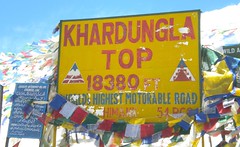 Our SUV climbed the pass slowly but effortlessly and we got to the peak within a couple of hours. Considered to be the world’s highest motor-able pass at 18380ft, the pass is kept open throughout the year for army movement. Even in July there was snow everywhere and we could touch the snow clinging to the mountain-side even as we drove up to the peak. We were almost shocked at how cold it was at the top and the intensity of the winds there. In spite of our down jackets, we couldn’t stand around for too long. It was funny to notice, though, that while we shivered our driver was standing around in his t-shirt looking totally unaffected by the weather !
Our SUV climbed the pass slowly but effortlessly and we got to the peak within a couple of hours. Considered to be the world’s highest motor-able pass at 18380ft, the pass is kept open throughout the year for army movement. Even in July there was snow everywhere and we could touch the snow clinging to the mountain-side even as we drove up to the peak. We were almost shocked at how cold it was at the top and the intensity of the winds there. In spite of our down jackets, we couldn’t stand around for too long. It was funny to notice, though, that while we shivered our driver was standing around in his t-shirt looking totally unaffected by the weather !
The descent into Nubra valley was quite spectacular as the mountains around took on a different hue from the Leh region; they just seemed 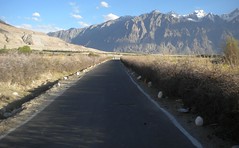 more bare and statuesque! We descended to the dry river bed and then turned west towards the villages of Hunder and Diskit. We stopped at Diskit first to check into a guesthouse there. Then, at around 4pm, we left for the village of Hunder, which was 6kms west. The drive to there was absolutely gorgeous as the road wound along the mountain-side just by the valley floor. We passed the sand dunes of Hunder and even spotted some Bactrian camels plodding thru the sands with excited tourists on their backs. On our driver’s suggestion we drove on to visit Hunder village’s Gompa first.
more bare and statuesque! We descended to the dry river bed and then turned west towards the villages of Hunder and Diskit. We stopped at Diskit first to check into a guesthouse there. Then, at around 4pm, we left for the village of Hunder, which was 6kms west. The drive to there was absolutely gorgeous as the road wound along the mountain-side just by the valley floor. We passed the sand dunes of Hunder and even spotted some Bactrian camels plodding thru the sands with excited tourists on their backs. On our driver’s suggestion we drove on to visit Hunder village’s Gompa first.
For a change the Gompa in Hunder wasn’t perched atop a lofty hill; it was right by the road! Unfortunately, the entire complex was undergoing some kind of reconstruction so there was rubble everywhere. 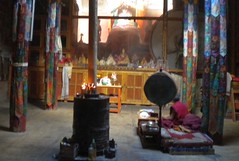 It was so chaotic that for a few minutes we couldn’t even find the entrance to the prayer hall. We finally found it hidden within a collapsed courtyard and had to step over large, broken building stones to get to it. But the minute we stepped in thru the doors, the chaos outside was completely forgotten. The prayer hall was dark and calm with a huge (almost a storey tall!) staue of Buddha against the far wall; it was encased within a large glass cabinet for protection. There were unpainted murals – part of the renovation work – on the other walls and they looked quite unique from the brightly painted ones we were used to seeing.
It was so chaotic that for a few minutes we couldn’t even find the entrance to the prayer hall. We finally found it hidden within a collapsed courtyard and had to step over large, broken building stones to get to it. But the minute we stepped in thru the doors, the chaos outside was completely forgotten. The prayer hall was dark and calm with a huge (almost a storey tall!) staue of Buddha against the far wall; it was encased within a large glass cabinet for protection. There were unpainted murals – part of the renovation work – on the other walls and they looked quite unique from the brightly painted ones we were used to seeing.
When we got back out of the Gompa, our driver pointed 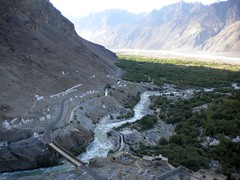 to some ruins atop a hillock before us and said that there were a couple of interesting Gompas amongst those ruins. To further entice us, he said that views of Hunder village and the Nubra valley were awesome from the top. This left us with no choice but to attempt the climb to the top. From the base it looked terribly difficult but once we started climbing, it wasn’t all that bad. Just as the driver had promised, we got wonderful views of the valley along the way and that distracted us from the pain of the climb.
to some ruins atop a hillock before us and said that there were a couple of interesting Gompas amongst those ruins. To further entice us, he said that views of Hunder village and the Nubra valley were awesome from the top. This left us with no choice but to attempt the climb to the top. From the base it looked terribly difficult but once we started climbing, it wasn’t all that bad. Just as the driver had promised, we got wonderful views of the valley along the way and that distracted us from the pain of the climb.
We visited about 3 shrines at the top of the hillock. They were all quite old, partially in ruins and very small. If it weren’t for the oil lamps burning in each one of them I would have thought that the Gompas were deserted too; obviously they weren’t. Each of them housed a lovely and unique image of Buddha surrounded by fading, ancient murals. They were all built right along the edge of the hillock and looked dangerously close to teetering over but also had the best views ever! We realized that we had the driver to thank for coaxing us into climbing up to the Gompas – we would have never attempted it on our own initiative!
Hunder is the furthest tourists can go to the west of Nubra Valley. So we turned around and headed back towards Diskit. The plan was  to stop at the sand dunes en route and take a closer look at the famed double-humped camels of Nubra. But we had to hurry ‘coz the 15-minute ride on these camels is offered only until 6:30pm and by the time we got to there, it was past the allotted time; the men handling the camels were already packing up for the day. They refused to let us ride the camels unless their manager, who sat at the ticket counter, agreed. Madhu, at his charming best, requested the manager sweetly and it worked ; we were able to procure 2 tickets for a quick ride on the camels across the sand dunes.
to stop at the sand dunes en route and take a closer look at the famed double-humped camels of Nubra. But we had to hurry ‘coz the 15-minute ride on these camels is offered only until 6:30pm and by the time we got to there, it was past the allotted time; the men handling the camels were already packing up for the day. They refused to let us ride the camels unless their manager, who sat at the ticket counter, agreed. Madhu, at his charming best, requested the manager sweetly and it worked ; we were able to procure 2 tickets for a quick ride on the camels across the sand dunes.
Said to have been left behind at the high-altitude desert dunes of Nubra valley during the trade crossings of Central Asia, these  Bactrian camels were originally natives of the Gobi Desert. Those days they were part of caravans that plied the Silk Route carrying goods from Central and South Asia. Today many of these camels have been domesticated for rides and transport around the desert region. The ride offered to tourists is a top draw in the Nubra valley and most visitors come here just for it; we were glad we got the chance too. Up close we found that these animals looked shorter than the single-humped ones we’d seen before. Also, understandably, the Bactrian ones were quite furry with thick tufts of hair around their necks and legs – they looked rather cute! We climbed atop them and were seated in between the two humps. Then the camels waddled across the dunes for exactly 15 minutes – it was an uneventful and bumpy but fun ride!
Bactrian camels were originally natives of the Gobi Desert. Those days they were part of caravans that plied the Silk Route carrying goods from Central and South Asia. Today many of these camels have been domesticated for rides and transport around the desert region. The ride offered to tourists is a top draw in the Nubra valley and most visitors come here just for it; we were glad we got the chance too. Up close we found that these animals looked shorter than the single-humped ones we’d seen before. Also, understandably, the Bactrian ones were quite furry with thick tufts of hair around their necks and legs – they looked rather cute! We climbed atop them and were seated in between the two humps. Then the camels waddled across the dunes for exactly 15 minutes – it was an uneventful and bumpy but fun ride!
Later we sat on the small mounds of sand dunes for a while enjoying the lovely scenery and cold breeze before heading back to Diskit for a quiet evening. On hindsight, we wished we had stayed somewhere close to the sand dunes (maybe in the village of Hunder?) so that we could have enjoyed that landscape longer.
The following morning we started early to visit the Diskit Gompa before heading to Panamik, which is to the north of Nubra valley. Since melting snow would increase water levels across the roads between Sumur and Panamik during the day, the plan was to tour Panamik and be back in Sumur by late afternoon at the latest.
Diskit Gompa is one of the largest and oldest monasteries in the Nubra valley. Like most other Buddhist Gompas in the Ladakh region, 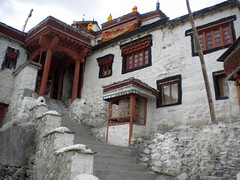 it clings to a mountain-side sitting just above the village. Luckily, vehicles can go right up to the base of the monastery from where it’s a short climb up to the prayer halls and shrines. We were amazed to find that all of these were immaculately maintained and preserved over the years. The monastery courtyard was pristine and in the early morning air looked absolutely wonderful. The insides of the shrines (we visited 3 in all) were as wonderfully maintained as the outside.
it clings to a mountain-side sitting just above the village. Luckily, vehicles can go right up to the base of the monastery from where it’s a short climb up to the prayer halls and shrines. We were amazed to find that all of these were immaculately maintained and preserved over the years. The monastery courtyard was pristine and in the early morning air looked absolutely wonderful. The insides of the shrines (we visited 3 in all) were as wonderfully maintained as the outside.
But the most exciting thing about Diskit Gompa was the huge  Maitreya statue that was built on a high terrace across from the village on a smaller hillock! We could see it clearly from the Gompa but seeing it from up-close while standing at its feet was just simply exhilarating! Unlike the Shanti Stupa in Leh, this one had been built by truly skilled craftsmen – it was a marvelous piece of work! At the time we were there, craftsmen and volunteers from the neighboring villages were working feverishly to get the monument and the adjoining area ready for a visit by the Dalai Lama who was to inaugurate it in about a week’s time! Things looked quite ready and only some finishing touches (and loads of cleanup – there was construction debris everywhere!) needed to be done. I’m sure they must have had everything in order by the time the Dalai Lama came to visit!
Maitreya statue that was built on a high terrace across from the village on a smaller hillock! We could see it clearly from the Gompa but seeing it from up-close while standing at its feet was just simply exhilarating! Unlike the Shanti Stupa in Leh, this one had been built by truly skilled craftsmen – it was a marvelous piece of work! At the time we were there, craftsmen and volunteers from the neighboring villages were working feverishly to get the monument and the adjoining area ready for a visit by the Dalai Lama who was to inaugurate it in about a week’s time! Things looked quite ready and only some finishing touches (and loads of cleanup – there was construction debris everywhere!) needed to be done. I’m sure they must have had everything in order by the time the Dalai Lama came to visit!
The drive east and then north to Panamik took us across the valley floor; it was wonderfully scenic! There were several shallow streams of melting snow on the roads but the Sumo was able to negotiate them quite easily. As we went further north, the scenery around us grew stark and more desert-like, with hardly any vegetation. At the village of Panamik, our driver parked the car by the side of the road and pointed to a concrete building, which seemed newly built half-way up the mountain-side; this was where we could find the hot springs that Panamik is famous for!
I’m not really sure what we were expecting when we walked up to the hot springs but the sight of unpainted, cement buildings by the side of a narrow stream was downright disappointing. There were several laborers working on the construction of more cement blocks and it’s only after walking around a bit did we realize that these were to be shower rooms for people to bathe in using the water that spouted from the hot springs. We touched the water in the stream and found it to be quite warm to the touch. But I doubt anybody would want to bathe in it; the springs had caused yellow-colored, frothy pools everywhere and they definitely didn’t look inviting. On the whole the place was quite boring and I wish we hadn’t bothered going there!
On our way back, on our driver’s suggestion we visited the hidden Yarab Tso (Yarab Lake). Somewhere mid-way between Sumur and Panamik, he drove off the road and into the valley floor, parked mid-way across and then directed us to walk. The valley floor was riddled with narrow streams of water; we were able to jump over most of them but at times had to remove our shoes and socks to wade through – it was a lot of fun. 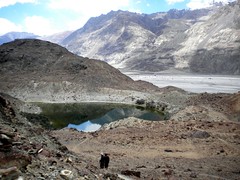 At the other end of the valley, we hiked up a rocky hillock (not too steep or tiring) and came up on its rim. On the other side, at the bottom, was a lovely, aqua-blue lake, which looked spectacular from the top. Madhu and our guide, the driver, decided to walk down to it but I decided to stay put; the afternoon heat had tired me out and I didn’t feel like exerting myself anymore. So I sat on a large boulder gazing at the lake while the guys walked down and around it easily; they enjoyed their walk while I loved my few minutes of solitude.
At the other end of the valley, we hiked up a rocky hillock (not too steep or tiring) and came up on its rim. On the other side, at the bottom, was a lovely, aqua-blue lake, which looked spectacular from the top. Madhu and our guide, the driver, decided to walk down to it but I decided to stay put; the afternoon heat had tired me out and I didn’t feel like exerting myself anymore. So I sat on a large boulder gazing at the lake while the guys walked down and around it easily; they enjoyed their walk while I loved my few minutes of solitude.
Our final stop for the day was the village of Sumur where the main attraction is its Gompa. We checked into a guesthouse for the night and then headed off to see the Gompa, which was about 2kms away. 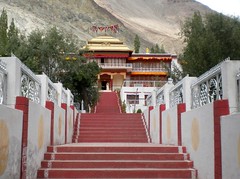 When we got there we found the main road leading up to the monastery being re-tarred and that the monastery itself had been repainted recently – all preparations for the Dalai Lama’s visit. Wide, terraced steps led from the gate up to the monastery building, which is 2-storied with a lovely, open verandah in the front. Because of the freshly repainted exteriors, the monastery didn’t really look 150 yrs old from the outside but the minute we stepped into the prayer hall, its antiquity was clearly visible; there were ageing murals, silk paintings and idols everywhere – it looked gorgeous! The monastic complex is said to contain several other shrines as well but we saw only the prayer hall and left.
When we got there we found the main road leading up to the monastery being re-tarred and that the monastery itself had been repainted recently – all preparations for the Dalai Lama’s visit. Wide, terraced steps led from the gate up to the monastery building, which is 2-storied with a lovely, open verandah in the front. Because of the freshly repainted exteriors, the monastery didn’t really look 150 yrs old from the outside but the minute we stepped into the prayer hall, its antiquity was clearly visible; there were ageing murals, silk paintings and idols everywhere – it looked gorgeous! The monastic complex is said to contain several other shrines as well but we saw only the prayer hall and left.
In the evening we walked around the village of Sumur and found more sand dunes along its western edge, which bordered the Nubra river. When we looped around we passed some lovely green fields ablaze with little yellow flowers! We passed several locals who gave us friendly smiles and two little girls who even posed for our pictures – it was too darn sweet! As we wandered around aimlessly, we lost track of time and soon it started to get dark. We then realized that we were somewhat lost with no idea how to get back to our guesthouse quickly. With no other option, we asked around and were directed by a couple of young girls to cut across a field to the road on the other side; the road would lead us to our guesthouse. We did just as they suggested and enjoyed a lovely walk thru the field and then jumped over a wooden fence to get to the road, making it back to the guesthouse just before it got completely dark!
The tour of Nubra valley gave us a unique feel of the northern-most part of India and its inhabitants. No tour of Ladakh could be complete without crossing the world’s highest (okay, maybe one of the highest) motor-able pass and taking a peek at the wonderful landscape on the other side. On hindsight, though, we need not have stayed for 2 nights. We could have easily skipped Panamik, toured Diskit and Sumur before leaving for Leh in the afternoon.


Great article again and very useful for my planning. Do you mind saying how much the taxi & lodging costs were?
Also I think there’s a bit of an HTML issue after the ‘We could have easily skipped Panamik’ bit.
Hi Kev,
I have fixed the HTML issue – Thanks for pointing it out.
Hotel Rates
* Diskit – Hotel Sand Dunes was 500 per night for a dbl room. It is probably the best value for money place in Diskit. Highly recommended.
* Sumur – K-Sar was 350 for a dbl … again good value for money. The caretaker is an interesting character. He doubles up as a contract porter for the India Army when they need to move supplies to the Siachen. Hence has a lot of interesting stories 🙂
Taxi was 6000 for the entire trip 3 days / 2 nights … Very expensive, but cheaper than the travel agent prices since we contacted the driver directly.
Cheers!
Amazing articulation….informative travel blog..Thanks for posting..
Thanks, Rahul!
Cheers,
Madhu